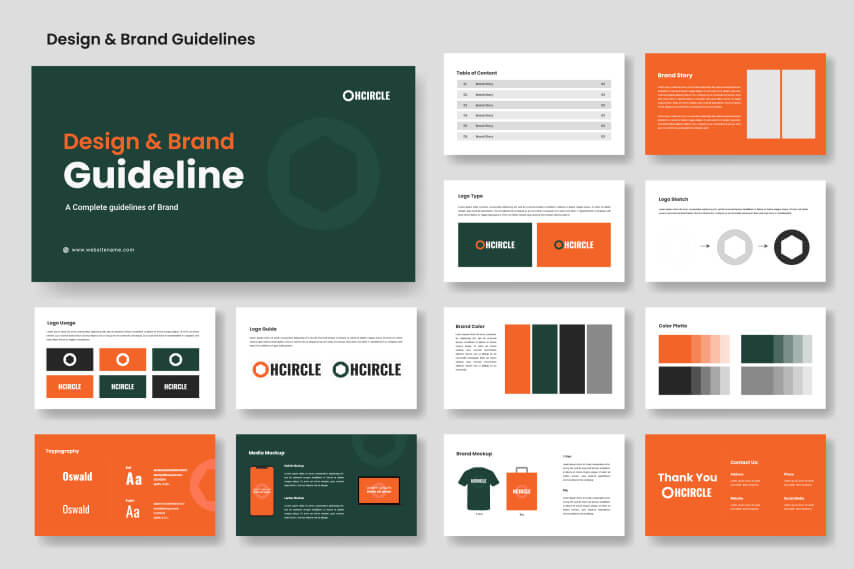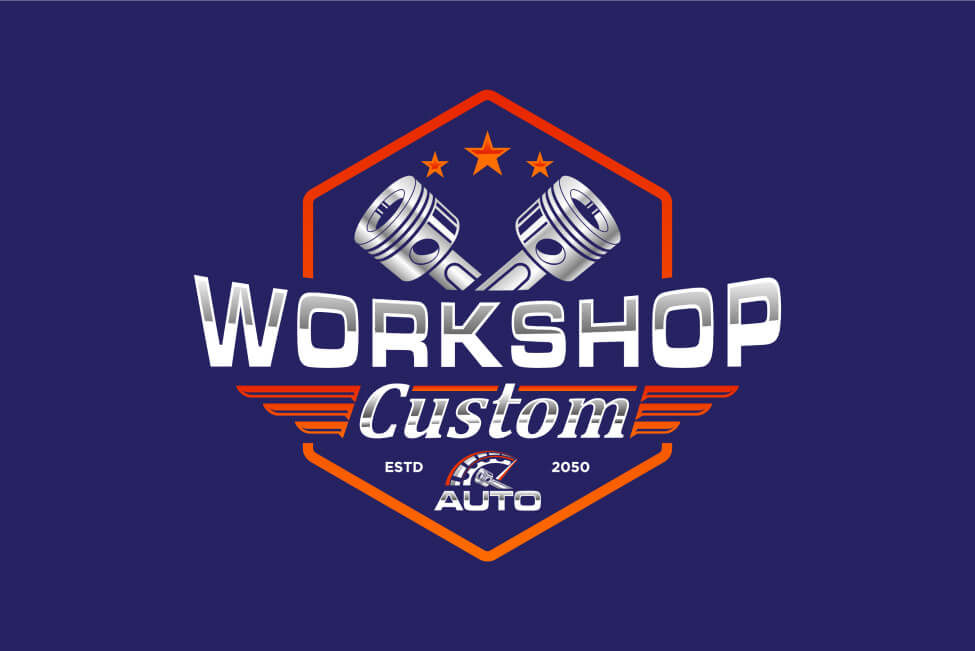
- Introduction
- What Are Brand Guidelines, and Why Are They Important?
- The Evolution of Brand Guidelines in the Digital Era
- Key Elements of Effective Brand Guidelines
- How to Develop a Brand Style Guide
- Importance of Consistency in Strong Brand Identity
- Role Of Custom Logo Designs In Brand Consistency
- Typography: Creating a Consistent Brand Voice
Introduction
Having a clear and consistent brand guideline is important to stand out in the overcrowded business market. Unique brand guidelines help in maintaining consistency in brand identity. It is your brand logo, brand tone, and the way you communicate with your customers that needs to be in sync. This blog explains the process of developing brand guidelines to establish and promote brand standards across relevant channels. Whether you are creating guidelines for the first time or not, these tips will help your brand shine.
What Are Brand Guidelines, and Why Are They Important?

Brand guidelines are also known as brand style guides. They are a set of rules that govern how your brand should look and sound. Logos, color tone, typography, and style are the important elements of brand guideline
s. Guidelines must display consistency in marketing and communication, both online and offline. This creates brand awareness and helps you remain loyal to the targeted audience. A lack of brand identity can lead to messages or images that overwhelm or mislead the target market. Creating a strong list of rules helps your brand gain more trust and recognition among customers. It retains customers and boosts brand credibility. Each employee and partner associated with the company must know the brand guidelines. This will help them create materials important for a consistent brand image.
The Evolution of Brand Guidelines in the Digital Era
Brand guidelines are no longer simple printed pieces of written content. They are an interactive source that can meet the demands of modern society. Modern tools such as Frontify, Canva, and Bynder have stepped up how brands govern their identity. They provide cloud-based solutions to keep the information manageable as well as up-to-date. These tools do not represent a simple style guide. They include real-time templates, library, and hub experiences to create the perfect branded content in record time. Real-time updates allow everyone to have access to the most recent assets. This is extremely helpful in minimizing discrepancy. Extra tools like drag-drop libraries make branding a bliss. Evolution improves the idea of collaboration, keeping internal and external partners in line with a single brand image. Considering the recent advancements, organizations can easily create perfect guidelines in the current fast-growing digital world.
Key Elements of Effective Brand Guidelines

Do you know that your brand guidelines define into which category your brand falls? The first element is your corporate identity. This means that the logo must be unique and show uniformity with your product. Another important feature is typography. It is about deciding the type of fonts to use. This is again very important, as fonts talk about the personality of your brand. Color choice is important as it explains the perception the market has of your brand. It is key to select proper color tones that represent brand uniformity. Another important aspect is brand persona, which is also called brand voice/brand tone. It determines how you speak to your audience, formally or informally. Finally, you’ll require rules of imagery, whether photographic, illustrative, or iconographic. Altogether, these features contribute to the clear and classy brand image.
How to Develop a Brand Style Guide
Creating a brand style guide is a daunting task. However, going through it step by step makes it easy. First, make sure you know who you are as a brand—your mission, values, and vision. From there, sketch your identity elements, including the logo, colors, typography, and imagery. State how these elements should be used and give examples to avoid misunderstanding. For instance, demonstrate how your logo should be displayed on a dark and light background. Talk about exact color codes and how you would like your brand to sound. For example, do you want it to be casual, friendly, or formal? Finally, encourage designers, marketers, business owners, and other stakeholders to provide feedback. This will ensure that the given guide represents the given brand. After creating a style guide, it is necessary to distribute it to your team members to keep consistency.
Importance of Consistency in Strong Brand Identity
Each aspect of your brand must speak coherence. Coherence in branding guarantees the clients are familiar with your company and trust its operations. It becomes easier for customers to connect your messages, images, communication, and content style. It’s like a guarantee. As a customer, you know what to expect when you are dealing with a particular business. This not only leaves a good impression but also strengthens the brand image in the long run. A lack of consistent branding can give the wrong impression to potential customers. It makes the business look less organized or professional. Brand consistency is key. Every time your audience sees material on your website, social media, or in your marketing campaigns, it makes your brand more recognizable and trustworthy. This gives you a more memorable presence, helping you become a reliable choice for customers.
Role Of Custom Logo Designs In Brand Consistency

Your logo is the first point of contact between your brand and the customers. It is very important to give time and thought to it to come up with a good one. Brand logos are the building blocks of your brand. They are the first means of communication. When a logo is used in consistent ways, people start to recognize it. Once memorized, customers remain confident in the company. Business owners need to consider how, where, and when to use the logo. It is also important to brainstorm on the logo forms. For example, if it needs to be horizontal, stacked, black and white, etc. Defining the minimum size and the space to be left around the logo is also important. This keeps the logo visibility clear. Using these rules, your logo will look polished no matter what hands it ends up in.
Typography: Creating a Consistent Brand Voice
Do you know that typography has a deep influence on your brand personality and communication style? Not only each font type is linked with a specific mood, use of the correct fonts creates a certain atmosphere. For example, a neat sans-serif shows professionalism. Whereas, a handwritten script is the correct choice for a playful brand. In brand standards, it is important to outline primary and secondary typeface, font size, and the correct line and character space. You must show when to use bolder, italic, or capital letters to highlight some words. Typography is a main aspect of writing. It makes the content easy to understand and complements your brand image. Be it for a website or a printed format, following typography guidelines enhance your brand identity.
The Role of Patterns and Textures in Branding
Beyond color and shapes, pattern and texture add character to your brand. These elements are a powerful tool for a brand’s visual aesthetic. Repetition provides your brand with harmony by placing similar icons or geometrical shapes together. Textures, whether smooth or contrasting, help stir up a feeling and add depth to your imagery. For example, a grainy texture might give a feeling of comfort and informality. Whereas, a polished metallic texture shows elegance and richness. While using patterns and textures, be sure to stick to your branding. Note the type of pattern or texture you are using remains consistent in your brand materials. Furthermore, add specific directions to your brand guidelines to explain how and where the brand elements can be used. This attention to detail can help your brands look better, and engaging. What’s better than giving a unique appeal to the consumers?
Streamline Brand Guidelines Template
Like logos, templates are lifesavers. They maintain brand identity and cut on the time and effort spent. They do it by limiting the number of unique designs required which saves time. Moreover, they also offer a set structure that your team can follow. Using templates minimizes the chances of using the brand logos, colors, and fonts, competitively. This minimizes the chances of mistakes especially if there are some people involved in content creation. In designing the templates, it is important to consider the purpose of the message. For example, using different templates for sales promotions or for company use. Make sure to keep it open enough to apply any new changes. However, also make sure to maintain the brand’s professional appearance and brand image. Templates save a lot of time when it comes to designing. A good set of templates will help you focus on creative rather than repetitive tasks.
How to Use Colors to Strengthen Your Brand Identity

Color is one of the most effective branding elements. It can evoke emotions and perceptions. Choosing the right shade for your brand is important for any brand growth. It reflects on the values related to your brand image. For example, blue has the notion of reliability, and green with growth and sustainability. Your brand guidelines need to display the actual color codes, be it RGB, HEX, or Pantone. This will help you use all your colors uniformly on your website and other social media platforms. Furthermore, it is also important to identify to know how to combine and apply color within particular settings. Using the correct colors in your logo design will uplift your brand and help it shine through in the future.
Brand Voice: Defining Your Brand’s Tone and Language
Brand tone defines the way your brand engages with its targeted customers. It dictates the tone you use to do all the dealings. From marketing to customer services, brand tone is something that takes you forward in the market. It is important to develop a clear tone of voice to remain relevant. A consistent brand tone helps your customers recognize you and the values you uphold. Your brand guidelines should specify the tone, be it formal, funny, or firm. It is also important to add how to behave in different situations concerning customers. For example, how to resolve a conflict or celebrate customers. With a clear and consistent brand tone, you can create a strong impression on customers. It defines your brand as approachable and believable to your target market, developing a good working relationship.
Imagery: The Power of Visual Content in Brand Identity
The use of images is a key factor in defining brand standards. It defines how to convey the brand message using visuals. This is why the right imagery—whether it’s photos, illustrations, or icons—can make people feel something. It helps your customers remind them of who you are. To find the right imagery for your brand, you ought to look for a style and tone. All these elements must be consistent with your brand values. If you are a fashion designer who specializes in luxury brands, your illustrations may include minimalistic designs. Whereas, bright and cheerful images represent a fun, youthful brand. Brands can also explore custom illustration styles for branding to ensure that their visuals reflect a unique and cohesive identity. Your brand image must focus on style, color, and tones as well. Consistency in images is very important as it keeps your brand seamless and professional.
How to Train Your Team on Brand Guidelines

It is necessary to communicate brand guidelines among team members. Everyone must know and practice to sustain harmony. Start with an interesting workshop or a lecture to discuss the importance of branding. Introduce the major concepts in your brand guideline and provide examples. Each team member must know how consistency can help sustain brand recognition and trust in real-life scenarios. Offer your colleagues a clear guide on the brand’s logos, colors, typeface, and voice. Develop a source containing all relevant guidelines, templates and assets. Encourage questions and inform about a clear set of expectations. It is important to remind your team annually about any changes to the guidelines. Awareness of the importance of brand guidelines in brand consistency is important. Once the standards are set, the team must display them in all forms of communication media.
Brand Guidelines for Social Media and Digital Platforms
In the era of digital marketing, it is important to have a uniform look and feel of the brand on social media and digital sites. It means using the same logo, colors, and fonts in all the posts, banners, and profiles. Your brand guidelines should clearly explain how your logos, colors, and other graphic images should be used. Also, your brand tone should be adjusted to each channel. For example, one can write more freely and with less formal language on Instagram as compared to other social platforms. It all depends on the nature of the platform and the audience. Make sure to mention the rule for other engaging content. Mention how to compose captions, hashtags, and visuals as well. This way, you can guarantee a recognizable and credible online presence.
The Importance Of Brand Guidelines For Small Businesses
Clear brand guidelines can mean a lot for small companies. They make it look professional and reliable even if it is a very small business. Standard guidelines also help avoid repetition of work, hence cutting down on time and money. Start simple, decide on your logo, fonts, and colors, and then grow. You can use free programs, such as Canva or Google Slides, to design and spread your guide. Unlike other marketing strategies, proper branding on a limited budget is possible. Small brands can now remain unique from the competition and earn the trust of the customers.
Updating and Evolving Brand Guidelines
Brand guidelines are not static documents. They must be adjusted as the market changes. Over time and product development, changes in logos, colors, or taglines are necessary. Brand guidelines should be revised and updated periodically. If not, the customers will never about the true identity of the brand. Make sure to inform everyone in your organization after updating brand guidelines. Remember to remain consistent as well. It is important to note that improving your brand guidelines does not mean reinventing your brand. It is about sustaining relevance. Mainly, it is about maintaining the core elements that make your brand unique.
Real-Life Brand Guidelines Examples

Real-life brand guidelines success stories can be used as a strong reference. It can inspire and guide companies working on brand guidelines. For example, NASA’s brand book has rules about when where, and how logos should be used. It also explains the use of typeface and the position of stars in every design. This represents its accuracy and history. Furthermore, Slack is a communication tool. It uses illustrations and bright colors in its logo to show innovation. Omsom is a food brand that uses an energetic image to match the brand’s spirit. All the above brands show that consistency is important to be artistic. Using such examples, one can understand the use of a style guide. It explains how brand guidelines can create an emotional bond with the target consumers. Using the best practices can keep your brand coherent and effective.
Common Mistakes to Avoid in Branding
If not done properly, brand guidelines can weaken your business image. It can create confusion for the consumer. The improper use of your logo, colors, or typography can affect brand recognition. Failing to establish a brand voice can result in inconsistent or uninspired content marketing. The use of too many fonts, color blends, or designs can also weaken the message. If you disregard the idea of the target audience, your customers will not value your brand. Another common mistake is to neglect updates. As markets change, it is important to review and adjust your brand standards. One of the most crucial drawbacks is not having team collaboration. To avoid these mistakes, make sure to have concise and easy rules. Make sure that your employees understand the importance of brand consistency.
Conclusion: The Secret to a Memorable Brand
Brand guidelines are not just a set of rules. It is a tool that keeps your brand identity consistent, reliable, and interesting. By using these guidelines, you can provide your audience with a professional appearance. It strengthens customer loyalty, and trust and differentiates your brand from the rest in the market. Take the time to create descriptive guidelines and watch your brand reach new heights! For example, elements like creating memorable brand mascots can play a powerful role in reinforcing your brand personality, making it more relatable and recognizable to your audience.
Contact us
Unleash your brand's visual potential. Our expert designers will create stunning graphics for your brand that leave a lasting impression. Get a free quote now.
Frequently Asked Questions
Brand guidelines are the rulebook of your brand. They maintain your images, tone and style in any place. Your brand may appear untidy and perplexed without them.
It includes your brand logo, brand colors, brand tone and voice, the layout and the visuals. They all combine to form the personality of your brand which is why it is important to be consistent and clear with them.
Brand guidelines talk about the logo, color scheme, fonts, layout and the brand tone. They are created so that the whole team is in sync with the fundamentals and use the same whether it is logo or visuals. It is important for you to create your own brand guideline by adding the same elements into it.
Repetition creates credibility and awareness. It is trustworthy when individuals perceive that your brand appears and sounds identically in all places. It is what makes them remember–and pick you.
Revise your guide every time your brand changes. A good check-in time is usually once every 1-2 years.
